User Manual
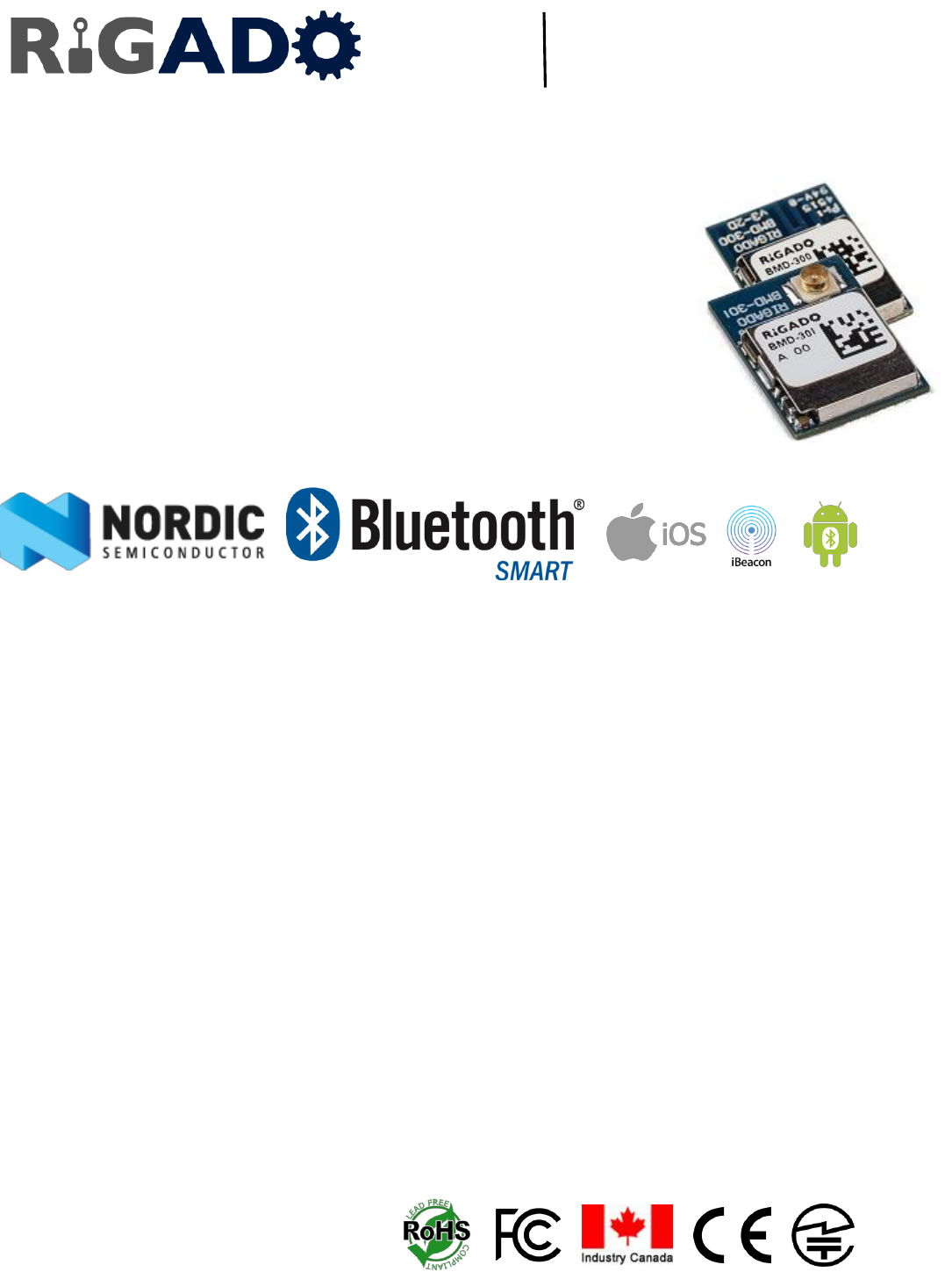
BMD-300-DS-V0.9.4 Page 1 of 25
Rigado LLC
3950 Fairview Industrial Dr.
Salem, Oregon 97302
866-6-RIGADO modules@rigado.com
www.rigado.com/modules
BMD-300 Series Module for Bluetooth 4.2 LE
The BMD-300 Series from Rigado is a line of powerful, highly flexible, ultra-low power
Bluetooth Smart modules based on the nRF52832 SoC from Nordic Semiconductor.
With an ARM® Cortex™ M4F CPU, embedded 2.4GHz transceiver, and integrated
antenna, they provide a complete RF solution with no additional RF design, allowing
faster time to market. Providing full use of the nRF52832’s capabilities and peripherals,
the BMD-300 Series can power the most demanding applications, all while simplifying
designs and reducing BOM costs. With an internal DC-DC converter and intelligent
power control, the BMD-300 Series provide class-leading power efficiency, enabling
ultra-low power sensitive applications. Regulatory pre-approvals reduce the burden
to enter the market, and the included BMD Software Suite provides access to great
features like a secure BLE & UART bootloader, iOS & Android Bluetooth libraries, and
more.
1. Features
Based on the Nordic nRF52832 SoC
Complete RF solution with integrated antenna
(BMD-300) or U.FL connector (BMD-301)
Integrated DC-DC converter
No external components required
ARM® Cortex™-M4F 32-bit processor
Serial Wire Debug (SWD)
Nordic SoftDevice ready
Over-the-Air (OTA) firmware updates
512kB embedded flash memory
64kB RAM
32 General Purpose I/O Pins
12-bit/200KSPS ADC
-40C to +85 Temperature Range
BMD Software Suite included
FCC: 2AA9B04 (BMD-300/BMD-301)
Three SPI Master/Slave (8 Mbps)
Low power comparator
Temperature sensor
Random Number Generator
Two 2-wire Master/Slave (I2C compatible)
I2S audio interface
UART (w/ CTS/RTS and DMA)
20 channel CPU independent Programmable
Peripheral Interconnect (PPI)
Quadrature Demodulator (QDEC)
128-bit AES HW encryption
5 x 32bit, 3 x 24bit Real Timer Counters (RTC)
NFC-A tag interface for OOB pairing
Dimensions: 14 x 9.8 x 1.9mm
IC: 12208A-04 (BMD-300/BMD-301)
Japan: 210-106799 (BMD-300)
2. Applications
App-cessories
iBeacons™
Low-Power Sensors
Connected Appliances
Lighting Products
Fitness devices
Wearables
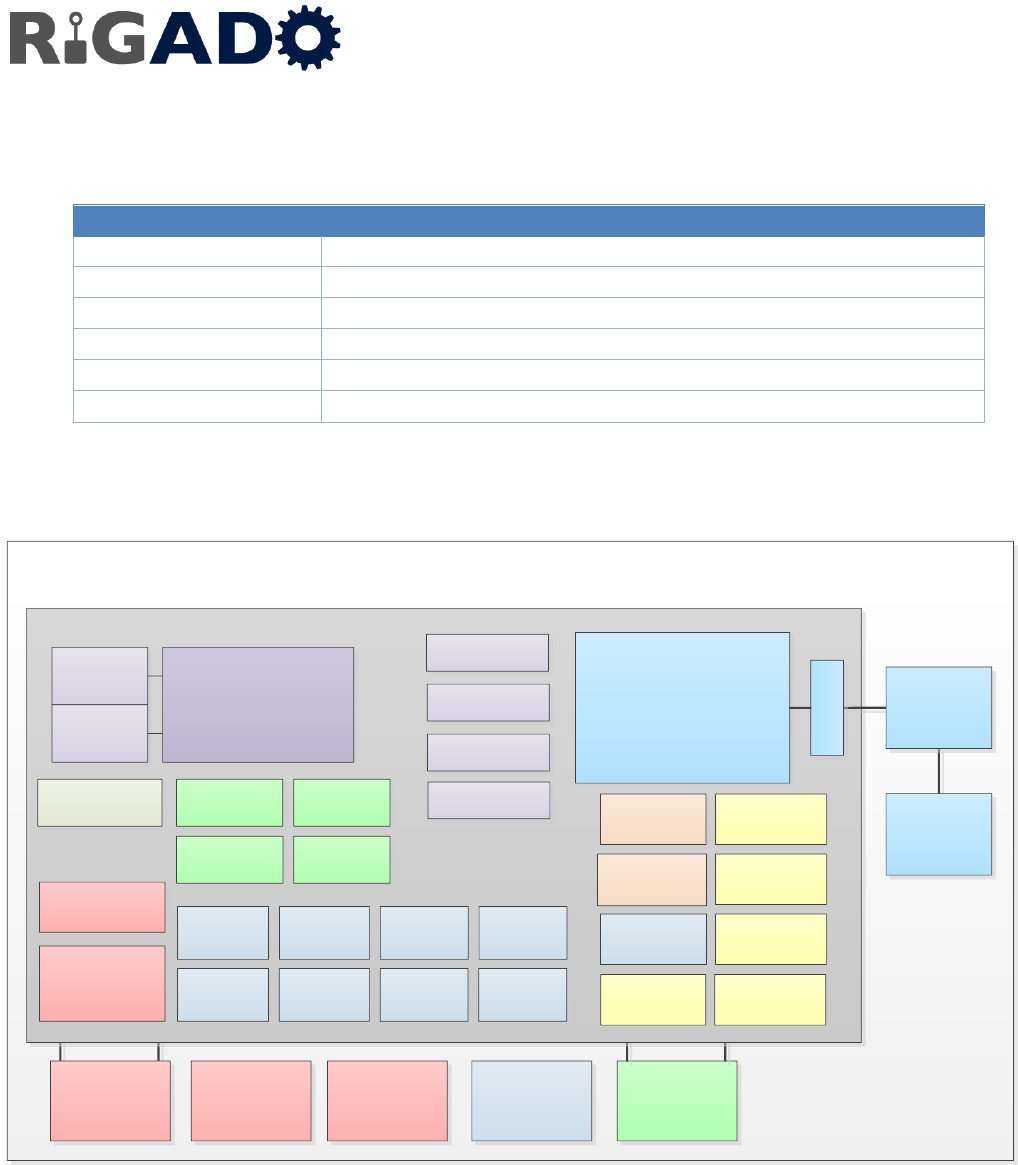
BMD-300 Series Module Datasheet
Bluetooth 4.2 LE
03/23/2016
BMD-300-DS-V0.9.4 Page 2 of 25
3. Ordering Information
Email modules@rigado.com for quotes and ordering or visit www.rigado.com/BMD-300
Part Number
Description
BMD-300-A-CT
BMD-300 module, Rev A, Cut Tape
BMD-300-A-R
BMD-300 module, Rev A, Tape & Reel, 1000 piece multiples
BMD-301-A-CT
BMD-301 module, Rev A, Cut Tape
BMD-301-A-R
BMD-301 module, Rev A, Tape & Reel, 1000 piece multiples
BMD-300-EVAL-S
BMD-300 Evaluation Kit with Segger J-Link programmer
BMD-301-EVAL-S
BMD-301 Evaluation Kit with Segger J-Link programmer w/antennas
Table 1 – Ordering Part Numbers
4. Block Diagram
BMD-300 Series Modules
32 MHz
Crystal
nRF52832
512kB
Flash
DC-DC
Inductor
Decoupling
Capacitors
Bulk
Capacitors
2.4GHz Radio
Multi-protocol
TWI
Master x2
SPI
Master x3
SPI Slave
X3
DC/DC Buck
Regulator
Core LDO
64
kB RAM
Low Power
Comparator
8-ch 12-bit
ADC
UART Quadrature
Decoder
SWD Debug &
Programming Temperature
Sensor
Clock
Management
Watchdog
Timer
Random Number
Gen
Timer x5
Accel Address
Resolver
AES CCM Mode
Encryption
AES ECB
Real Time
Counter x3
GPIO Task
Event Blocks
Programmable
Peripheral
Interconnect
ARM Cortex-M4F
@ 64MHz Matching
Network
Antenna
/ U.FL
GPIO x32
(Analog x8)
I2S
TWI Slave
x2 PWM PDM
General
Purpose
Comparator
NFC Tag
Balun
Figure 1 – Block Diagram

BMD-300 Series Module Datasheet
Bluetooth 4.2 LE
03/23/2016
BMD-300-DS-V0.9.4 Page 3 of 25
Table of Contents
1. FEATURES ............................................................................................................................................................ 1
2. APPLICATIONS ..................................................................................................................................................... 1
3. ORDERING INFORMATION ................................................................................................................................... 2
4. BLOCK DIAGRAM ................................................................................................................................................. 2
5. QUICK SPECIFICATIONS ........................................................................................................................................ 4
6. PIN DESCRIPTIONS ............................................................................................................................................... 5
6.1 RIGDFU PIN FUNCTIONS ..................................................................................................................................................................... 6
6.2 BMDWARE PIN FUNCTIONS ................................................................................................................................................................. 7
7. ELECTRICAL SPECIFICATIONS ................................................................................................................................ 8
7.1 ABSOLUTE MAXIMUM RATINGS............................................................................................................................................................. 8
7.2 OPERATING CONDITIONS ..................................................................................................................................................................... 8
7.3 GENERAL PURPOSE I/O ....................................................................................................................................................................... 8
7.4 DEBUG & PROGRAMMING ................................................................................................................................................................... 9
7.5 CLOCKS ............................................................................................................................................................................................ 9
8. FIRMWARE ........................................................................................................................................................ 10
8.1 FACTORY IMAGE .............................................................................................................................................................................. 10
8.1.1 Firmware Version ‘AA’ ........................................................................................................................................... 10
8.2 SOFTDEVICES .................................................................................................................................................................................. 10
8.2.1 S132 ........................................................................................................................................................................ 10
8.2.2 S212 ........................................................................................................................................................................ 11
8.2.3 S332 ........................................................................................................................................................................ 11
8.3 MAC ADDRESS INFO ........................................................................................................................................................................ 12
9. MECHANICAL DATA ........................................................................................................................................... 13
9.1 BMD-300 DIMENSIONS ................................................................................................................................................................... 13
9.2 BMD-301 DIMENSIONS ................................................................................................................................................................... 13
9.3 RECOMMENDED PCB LAND PAD ......................................................................................................................................................... 14
10. MODULE MARKING ............................................................................................................................................ 14
10.1 BMD-300 MODULE MARKING .......................................................................................................................................................... 14
10.2 BMD-301 MODULE MARKING .......................................................................................................................................................... 15
11. RF DESIGN NOTES .............................................................................................................................................. 15
11.1 RECOMMENDED RF LAYOUT & GROUND PLANE ..................................................................................................................................... 15
11.2 MECHANICAL ENCLOSURE .................................................................................................................................................................. 16
12. EVALUATION BOARDS ....................................................................................................................................... 16
13. CUSTOM DEVELOPMENT ................................................................................................................................... 16
14. BLUETOOTH QUALIFICATION (PENDING) ........................................................................................................... 17
15. REGULATORY STATEMENTS ............................................................................................................................... 17
15.1 FCC STATEMENT: ............................................................................................................................................................................ 17
15.2 FCC IMPORTANT NOTES: ................................................................................................................................................................... 17
15.3 IC STATEMENT: ............................................................................................................................................................................... 19
15.4 IC IMPORTANT NOTES: ...................................................................................................................................................................... 19
15.5 CE REGULATORY: ............................................................................................................................................................................. 20
15.6 JAPAN (MIC) .................................................................................................................................................................................. 20
15.7 AUSTRALIA / NEW ZEALAND ............................................................................................................................................................... 21
15.8 APPROVED EXTERNAL ANTENNAS......................................................................................................................................................... 21
16. SOLDER REFLOW TEMPERATURE-TIME PROFILE ................................................................................................ 21
16.1 MOISTURE SENSITIVITY LEVEL ............................................................................................................................................................. 21
17. PACKAGING AND LABELING ............................................................................................................................... 22
17.1 CARRIER TAPE DIMENSIONS ................................................................................................................................................................ 22
17.2 REEL PACKAGING ............................................................................................................................................................................. 22
17.3 PACKAGING LABEL ............................................................................................................................................................................ 23
18. CAUTIONS .......................................................................................................................................................... 24
19. LIFE SUPPORT POLICY ........................................................................................................................................ 24
20. DOCUMENT HISTORY ......................................................................................................................................... 24
21. RELATED DOCUMENTS ....................................................................................................................................... 25

BMD-300 Series Module Datasheet
Bluetooth 4.2 LE
03/23/2016
BMD-300-DS-V0.9.4 Page 4 of 25
5. Quick Specifications
Bluetooth
Version
4.2 (Bluetooth Smart) Concurrent Central & Peripheral (S132)
Security
AES-128
LE connections
up to 8 as Central, or up to 7 as Central and 1 as Peripheral,
Observer, Broadcaster (S132)
Radio
Frequency
2.360GHz to 2.500GHz
Modulations
GFSK at 1 Mbps, 2 Mbps data rates
Transmit power
+4 dBm
Receiver sensitivity
-96 dBm (BLE mode)
Antenna
Integrated
Current Consumption
TX only @ +4 dBm, 0 dBm @ 3V, DCDC enabled
7.5 mA, 5.3 mA
TX only @ +4 dBm, 0 dBm
16.6 mA, 11.6 mA
RX only @ 1 Mbps @ 3V, DCDC enabled
5.4 mA
RX only @ 1 Mbps
11.7 mA
CPU @ 64MHz from flash, from RAM
7.4 mA, 6.7 mA
CPU @ 64MHz from flash, from RAM @ 3V, DCDC
3.7 mA, 3.3 mA
System Off , On
0.7µA, 1.2 µA
Additional current for RAM retention
20 nA / 4K block
Dimensions
Length
14.0 mm ± 0.2mm
Width
9.8 mm ± 0.2mm
Height
1.9 mm ± 0.1mm
Hardware
Interfaces
SPI Master/Slave x 3
UART
Two-Wire Master/Slave (I2C) x 2
GPIO x 32
I2S
PWM
PDM
Power supply
1.7V to 3.6V
Temperature Range
-40 to +85°C
Certifications
FCC
FCC part 15 modular certification
BMD-300 FCC ID: 2AA9B04
BMD-301 FCC ID: 2AA9B04
IC
Industry Canada RSS-210 modular certification
BMD-300 IC: 12208A-04
BMD-301 IC: 12208A-04
CE
EN 60950-1: 2011-01 3.1 (a) : Health and Safety of the User
EN 301 489-17 V2.2.1 3.1 (b) : Electromagnetic Compatibility
EN 300 328 V1.8.1 3.2 :Effective use of spectrum allocated
Japan (TELEC)
Ministry of Internal Affairs and Communications (MIC) of Japan pursuant to
the Radio Act of Japan: 210-106799
Australia / New Zealand
AS/NZS 4268 :2012+AMDT 1:2013, Radio equipment and systems – Short
range devices
Bluetooth
RF-PHY Component (Tested) – DID: TBD (March 2016)
Table 2 – Quick Specifications

BMD-300 Series Module Datasheet
Bluetooth 4.2 LE
03/23/2016
BMD-300-DS-V0.9.4 Page 5 of 25
6. Pin Descriptions
Figure 2 – Pin out (Top View)
Pin description
Pin
Name
Direction
Description
6
P0.25
In/Out
GPIO3
7
P0.26
In/Out
GPIO3
8
P0.27
In/Out
GPIO3
9
P0.28
In/Out
GPIO/AIN43
10
P0.29
In/Out
GPIO/AIN53
11
P0.30
In/Out
GPIO/AIN63
12
P0.31
In/Out
GPIO/AIN73
13
P0.00
In/Out
GPIO/XTAL1 (32.768kHz)
14
P0.01
In/Out
GPIO/XTAL2 (32.768kHz)
15
P0.02
In/Out
GPIO/AIN0
19
P0.03
In/Out
GPIO/AIN1
20
P0.04
In/Out
GPIO/AIN2
21
P0.05
In/Out
GPIO/AIN3
22
P0.06
In/Out
GPIO
23
P0.07
In/Out
GPIO
24
P0.08
In/Out
GPIO
25
P0.09
In/Out
GPIO/NFC1
26
P0.10
In/Out
GPIO/NFC2
27
P0.11
In/Out
GPIO
28
P0.12
In/Out
GPIO
31
P0.13
In/Out
GPIO
32
P0.14
In/Out
GPIO/TRACEDATA[3]
33
P0.15
In/Out
GPIO/TRACEDATA[2]
34
P0.16
In/Out
GPIO/TRACEDATA[1]
35
P0.17
In/Out
GPIO

BMD-300 Series Module Datasheet
Bluetooth 4.2 LE
03/23/2016
BMD-300-DS-V0.9.4 Page 6 of 25
Pin
Name
Direction
Description
36
P0.18
In/Out
GPIO/TRACEDATA[0]/SWO
37
P0.19
In/Out
GPIO
38
P0.20
In/Out
GPIO/TRACECLK
39
P0.21
In/Out
GPIO/ RESET
̅
̅
̅
̅
̅
̅
̅
̅
1
40
P0.22
In/Out
GPIO3
41
P0.23
In/Out
GPIO3
42
P0.24
In/Out
GPIO3
43
SWCLK
In
SWD Clock
44
SWDIO
In/Out
SWD IO
17
VCC
Power
+1.7V to +3.6V2
1, 2, 3, 4, 5, 16, 18, 29,
30, 45, 46, 47
GND
Power
Electrical Ground
Note 1: The RESET
̅
̅
̅
̅
̅
̅
̅
̅
function can be assigned to another GPIO during programming. P0.21 is the default used by Rigado
and Nordic example applications and development kits.
Note 2: An internal 4.7µF bulk capacitor is included on the module. However, it is good design practice to add additional
bulk capacitance as required for your application, i.e. those with heavy GPIO usage and/or current draw.
Note 3: These pins are in close proximity to the nRF52 radio power supply and antenna pins. Radio performance
parameters, such as sensitivity, may be affected by high frequency digital I/O with large sink/source current on these
pins. Nordic recommends using only low frequency, low-drive functions when possible.
Table 3 – Pin Descriptions
6.1 RigDFU Pin Functions
Rigado RigDFU is programmed on the BMD-300 Series at the factory. Two GPIO pins are configured as UART pins
for transferring new firmware images to the BMD-300. Pins are configured only when bootloader is running, and
are fully available to the application firmware. RigDFU can be removed from the BMD-300 by performing a full-
chip erase.
Pin
Name
Direction
RigDFU Functions
22
P0.06
Out
UART TX for bootloader
Hi-Z until bootloader activation message received on UART RX.
24
P0.08
In
UART RX for bootloader
Internal 12kΩ pull-down enabled
Table 4 – RigDFU Functions

BMD-300 Series Module Datasheet
Bluetooth 4.2 LE
03/23/2016
BMD-300-DS-V0.9.4 Page 7 of 25
6.2 BMDware Pin Functions
Rigado BMDware is programmed on the BMD-300 Series at the factory. BMDware provides UART-to-BLE Bridge,
beaconing, and Direct Test Mode (DTM) functionality. The pins in Table 5 below describe the pin functionality in
BMDware. DTM Mode, Beacon-Only Mode, and AT Command Mode pin states are checked at BMDware start-up
to configure BMDware as required by the user, and are then set to Hi-Z to conserve power. For further details on
BMDware operation, please see the BMDware Datasheet that can be found at www.rigado.com. BMDware can be
overwritten by RigDFU with custom application firmware, or removed along with RigDFU by a full chip erase.
Pin
Name
Direction
BMDware Functions
21
P0.05
Out
Bridge UART RTS
Disabled in Beacon-Only & DTM modes, N/C if not used.
22
P0.06
Out
Bridge UART TX
Disabled in Beacon-Only & DTM modes, N/C if not used.
23
P0.07
In
Bridge UART CTS
Disabled in Beacon-Only & DTM modes, N/C if not used.
24
P0.08
In
Bridge UART RX
Disabled in Beacon-Only & DTM modes, N/C if not used.
27
P0.11
Out
DTM UART TX
Only enabled in DTM mode; N/C if not used.
28
P0.12
In
DTM UART RX / DTM Mode
Only enabled in DTM mode; N/C if not used.
On BMDware Start-up:
High = Enter DTM mode; Low = Enter Normal Operation
Internal 12kΩ pull-down during BMDware start-up, then Hi-Z
31
P0.13
In
Beacon Only Mode
On BMDware Start-up:
High = Bridge UART enabled; Low = Bridge UART disabled
Internal 12kΩ pull-up during BMDware start-up, then Hi-Z
32
P0.14
In
UART AT Command Mode
On BMDware Start-up:
High = Full pass-through mode; Low = AT command mode
Internal 12kΩ pull-up during BMDware start-up, then Hi-Z
Table 5 – BMDware Functions at Start-up
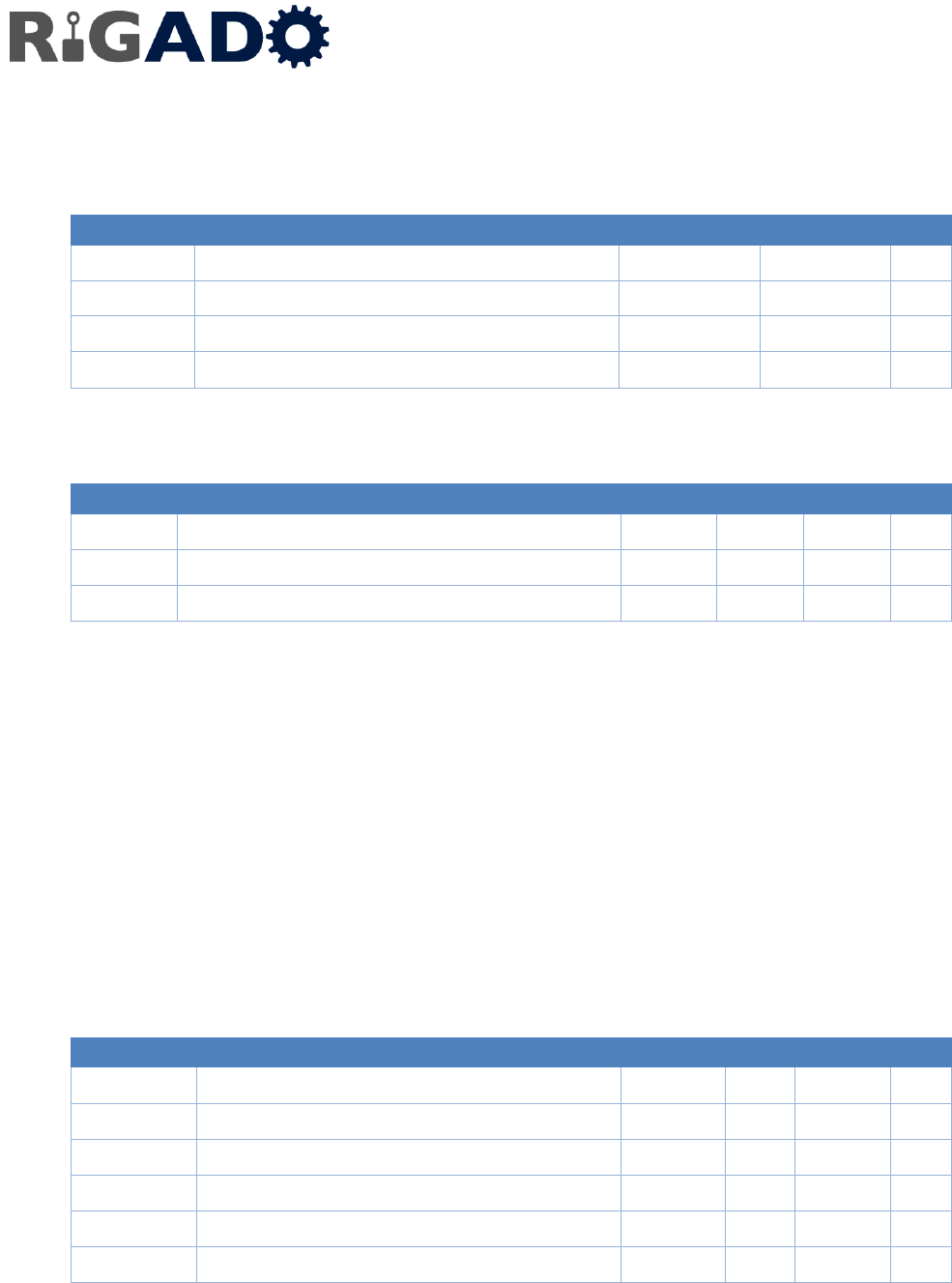
BMD-300 Series Module Datasheet
Bluetooth 4.2 LE
03/23/2016
BMD-300-DS-V0.9.4 Page 8 of 25
7. Electrical Specifications
7.1 Absolute Maximum Ratings
Symbol
Parameter
Min.
Max.
Unit
VCC_MAX
Voltage on supply pin
-0.3
3.9
V
VIO_MAX
Voltage on GPIO pins (VCC > 3.6V)
-0.3
3.9
V
VIO_MAX
Voltage on GPIO pins (VCC ≤ 3.6V)
-0.3
VCC + 0.3V
V
TS
Storage Temperature Range
-40
125
°C
Table 6 – Absolute Maximum Ratings
7.2 Operating Conditions
Symbol
Parameter
Min.
Typ.
Max.
Unit
VCC
Operating supply voltage
1.7
3.0
3.6
V
TR_VCC
Supply rise time (0V to 1.7V)
-
-
60
ms
TA
Operating Ambient Temperature Range
-40
25
85
°C
Table 7 – Operating Conditions
7.3 General Purpose I/O
The general purpose I/O is organized as one port enabling access and control of the 32 available GPIO pins through
one port. Each GPIO can be accessed individually with the following user configurable features:
Input/output direction
Output drive strength
Internal pull-up and pull-down resistors
Wake-up from high or low level triggers on all pins
Trigger interrupt on all pins
All pins can be used by the PPI task/event system; the maximum number of pins that can be interfaced
through the PPI at the same time is limited by the number of GPIOTE channels
All pins can be individually configured to carry serial interface or quadrature demodulator signals
Symbol
Parameter
Min.
Typ.
Max.
Unit
VIH
Input High Voltage
0.7 x VCC
-
VCC
V
VIL
Input Low Voltage
VSS
-
0.3 x VCC
V
VOH
Output High Voltage
VCC − 0.4
-
VCC
V
VOL
Output Low Voltage
VSS
-
VSS + 0.4
V
RPU
Pull-up Resistance
11
13
16
kΩ
RPD
Pull-down Resistance
11
13
16
kΩ
Table 8 – GPIO
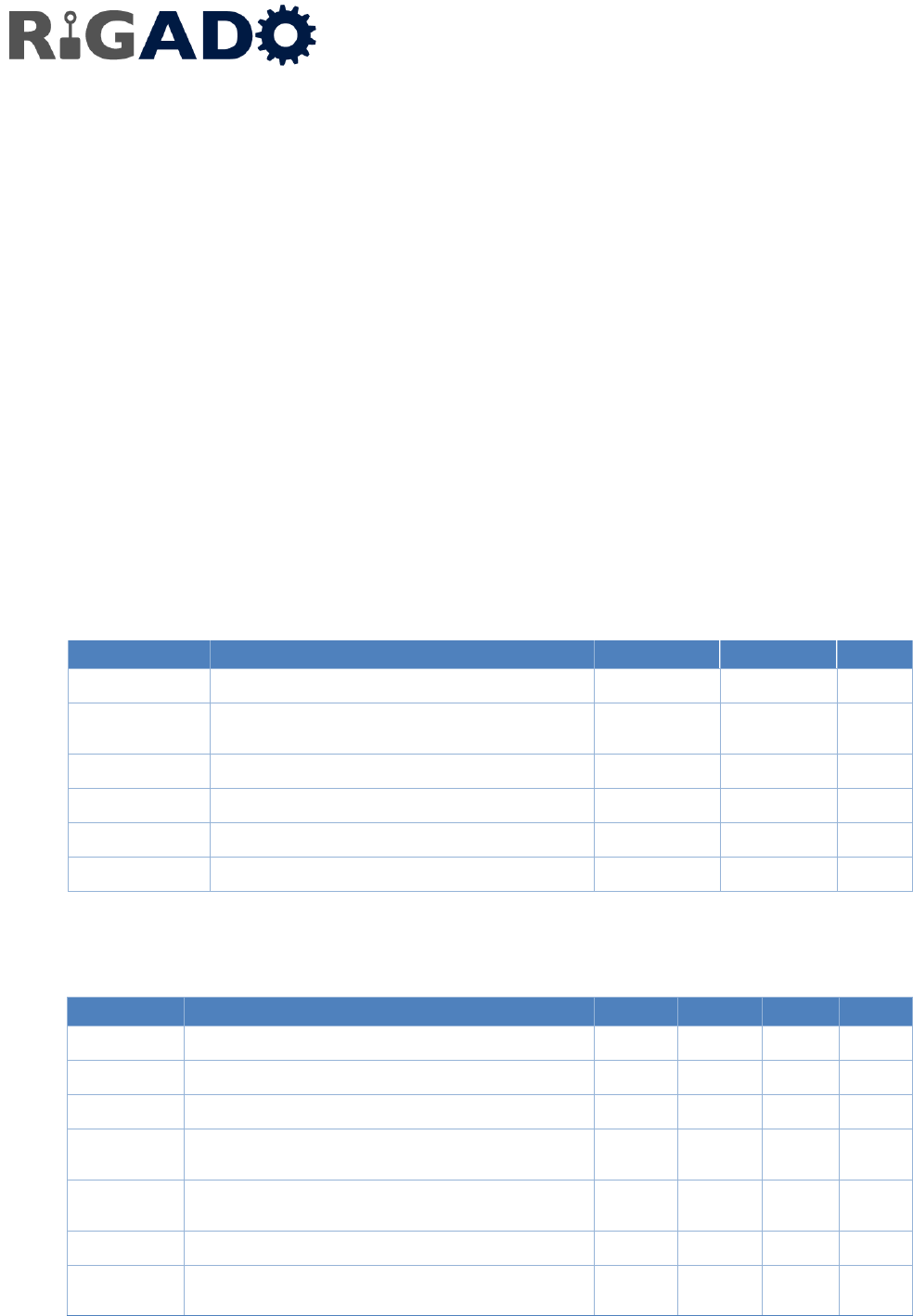
BMD-300 Series Module Datasheet
Bluetooth 4.2 LE
03/23/2016
BMD-300-DS-V0.9.4 Page 9 of 25
7.4 Debug & Programming
The BMD-300 support the two pin Serial Wire Debug (SWD) interface and offers flexible and powerful mechanism
for non-intrusive debugging of program code. Breakpoints, single stepping, and instruction trace capture of code
execution flow are part of this support.
The BMD-300 also supports ETM and ITM trace. Trace data from the ETM and the ITM is sent to an external
debugger via a 4-bit wide parallel trace port. In addition to parallel trace, the TPIU supports serial trace via the
Serial Wire Output (SWO) trace protocol.
7.5 Clocks
The BMD-300 module requires two clocks, a high frequency clock and a low frequency clock.
The high frequency clock is provided on-module by a high-accuracy 32-MHz crystal as required by the
nRF52832 for radio operation.
The low frequency clock can be provided internally by an RC oscillator or synthesized from the fast clock; or
externally by a 32.768 kHz crystal. An external crystal provides the lowest power consumption.
32.768 kHz Crystal (LFXO)
Symbol
Parameter
Typ.
Max.
Unit
FNOM_LFXO
Crystal frequency
32.768
-
kHz
FTOL_LFXO_BLE
Frequency tolerance, Bluetooth low energy
applications
-
±250
ppm
CL_LFXO
Load Capacitance
-
12.5
pF
C0_LFXO
Shunt Capacitance
-
2
pF
RS_LFXO
Equivalent series resistance
-
100
kΩ
Cpin
Input Capacitance on XL1 & XL2 pads
4
-
pF
Table 9 – 32.768 kHz Crystal
32.768 kHz Oscillator Comparison
Symbol
Parameter
Min.
Typ.
Max.
Unit
ILFXO
Current for 32.768kHz Crystal Oscillator
-
0.25
-
µA
ILFRC
Current for 32.768kHz RC Oscillator
-
0.6
1
µA
ILFSYNT
Current for 32.768kHz Synthesized Oscillator
-
100
-
µA
fTOL_LFXO_BLE
Frequency Tolerance, 32.768kHz Crystal
Oscillator (BLE Stack)
-
-
±250
ppm
fTOL_LFXO_ANT
Frequency Tolerance, 32.768kHz Crystal
Oscillator (ANT Stack)
-
-
±100
ppm
f TOL_LFRC
Frequency Tolerance, 32.768kHz RC Oscillator
-
-
±2
%
fTOL_LFSYNT
Frequency Tolerance, 32.768kHz Synthesized
Oscillator
-
-
±8
ppm
Table 10 – 32.768 kHz Oscillator

BMD-300 Series Module Datasheet
Bluetooth 4.2 LE
03/23/2016
BMD-300-DS-V0.9.4 Page 10 of 25
8. Firmware
8.1 Factory Image
All modules are shipped with factory programmed firmware. The factory programmed firmware version is
indicated on the label, see Figure 3 – MAC Address on Label.
8.1.1 Firmware Version ‘AA’
Factory firmware version ‘AA’ contains the Rigado RigDFU OTA and Serial bootloader, Nordic S132 SoftDevice,
and BMDware. Modules can be programmed with customer code via BLE and UART interfaces using Rigado
provided tools. Examples apps for iOS and Android are provided that utilize the Rigablue Library for easy OTA
updates. Visit the BMD Software Suite page at www.rigado.com for more information. Note: A full chip erase
will clear the Rigado assigned MAC address from memory; see section 8.3 “MAC Address Info” on how to
retain it.
8.2 SoftDevices
Nordic Semiconductor protocol stacks are known as SoftDevices. SoftDevices are pre-compiled, pre-linked
binary files. SoftDevices can be programmed in nRF52 series SoCs and are downloadable from the Nordic
website. The BMD-300 with the nRF52832 SoC supports the S132 (BLE Central & Peripheral), S212 (ANT) and
S312 (ANT and BLE) SoftDevices.
8.2.1 S132
The S132 SoftDevice is a Bluetooth® low energy (BLE) Central and Peripheral protocol stack solution
supporting up to three Central and one Peripheral simultaneous connections and concurrent Observer and
Broadcaster roles. It integrates a low energy Controller and Host, and provides a full and flexible API for
building Bluetooth low energy System on Chip (SoC) solutions.
Key Features
Bluetooth 4.2 compliant low energy single-mode
protocol stack suitable for Bluetooth Smart products
Concurrent Central, Observer, Peripheral, and
Broadcaster roles with up to:
o Three connections as a central
o One connection as a peripheral
o Observer
o Broadcaster
Link layer
L2CAP, ATT, and SM protocols
GATT and GAP APIs
GATT Client and Server
Complementary nRF52 SDK including Bluetooth profiles
and example applications
Master Boot Record for over-the-air device firmware
update
Memory isolation between application and protocol
stack for robustness and security
Thread-safe supervisor-call based API
Asynchronous, event-driven behavior
No RTOS dependency
o Any RTOS can be used
No link-time dependencies
o Standard ARM® CortexTMM4F project
configuration for application development
Support for concurrent and non-concurrent
multiprotocol operation
o Concurrent with the Bluetooth stack using
concurrent multiprotocol timeslot API
Alternate protocol stack in application space

BMD-300 Module Datasheet
Bluetooth 4.1 LE
03/08/2016
BMD-300-301-DS-V0.9 PRELIMINARY Page 11 of 25
8.2.2 S212
The S212 SoftDevice is an ANT protocol stack solution that provides a full and flexible Application
Programming Interface (API) for building ANT System on Chip (SoC) solutions for the nRF52832 chip. The S212
SoftDevice simplifies combining the ANT protocol stack and an application on the same CPU.
Key Features
Advanced ANT stack
Simple to complex network topologies:
o Peer-to-peer, Star, Tree, Star-to-star and
more
Up to 15 logical channels, each with configurable:
o Channel type, ID and period
o RF frequency
o Networks
Broadcast, Acknowledged, and Burst Data modes
Device search, pairing and proximity support
Enhanced ANT features:
o Advanced Burst Transfer mode (up to 60
kbps)
o Up to 15 channels encryption (AES-128)
support
o Additional networks – up to 8
o Event Filtering and Selective Data Updates
o Asynchronous Transmission
o Fast Channel Initiation
SoftDevice features
Built-in NVM access and radio coexistence
management
Master Boot Record for over-the air device firmware
update
Memory isolation between application and protocol
stack for robustness and security
Thread-safe supervisor-call based API
Asynchronous, event-driven behavior
No RTOS dependency
o Any RTOS can be used
o No link-time dependencies
o Standard ARM® Cortex™ -M4F project
configuration for application development
Support for concurrent and non-concurrent
multiprotocol operation
Concurrent multiprotocol timeslot API
Alternate protocol stack running in application space
8.2.3 S332
The S332 SoftDevice is a combined ANT™ and Bluetooth® low energy (BLE) protocol stack solution. It supports
all four Bluetooth low energy roles (central, peripheral, observer, broadcaster) and ANT.
The S332 SoftDevice provides a full and flexible Application Programming Interface (API) for building
concurrent ANT and BLE System on Chip (SoC) solutions. It simplifies combining an ANT and BLE protocol stack
and an application on the same CPU, therefore eliminating the need for an added device to support
concurrent multiprotocol.
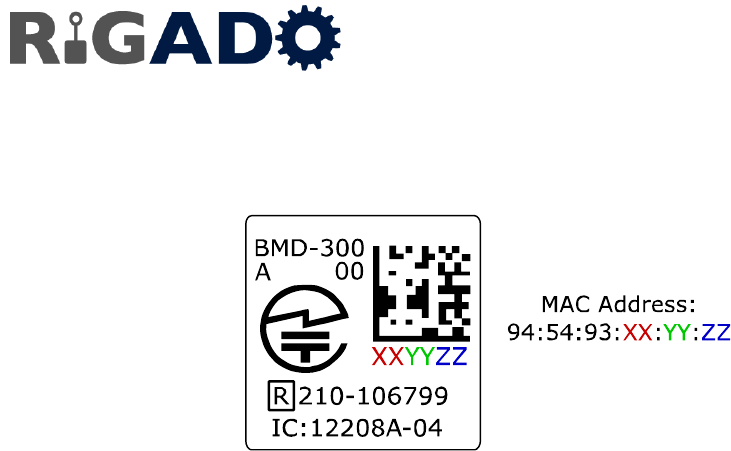
BMD-300 Series Module Datasheet
Bluetooth 4.2 LE
03/23/2016
BMD-300-DS-V0.9.4 Page 12 of 25
8.3 MAC Address Info
The BMD-300 module comes preprogrammed with a unique MAC address from the factory. The MAC address
is also printed on a 2D barcode on the top of the module
Figure 3 – MAC Address on Label
The 6-byte BLE Radio MAC address is stored in the nRF52832 UICR at NRF_UICR_BASE+0x80 LSB first. Please
read the MAC Address Provisioning application note if you are not using the built in bootloader to avoid
erasing/overwriting the MAC address during programming.
UICR Register:
NRF_UICR + 0x80 (0x10001080): MAC_Addr [0] (0xZZ)
NRF_UICR + 0x81 (0x10001081): MAC_Addr [1] (0xYY)
NRF_UICR + 0x82 (0x10001082): MAC_Addr [2] (0xXX)
NRF_UICR + 0x83 (0x10001083): MAC_Addr [3] (0x93)
NRF_UICR + 0x84 (0x10001084): MAC_Addr [4] (0x54)
NRF_UICR + 0x85 (0x10001085): MAC_Addr [5] (0x94)
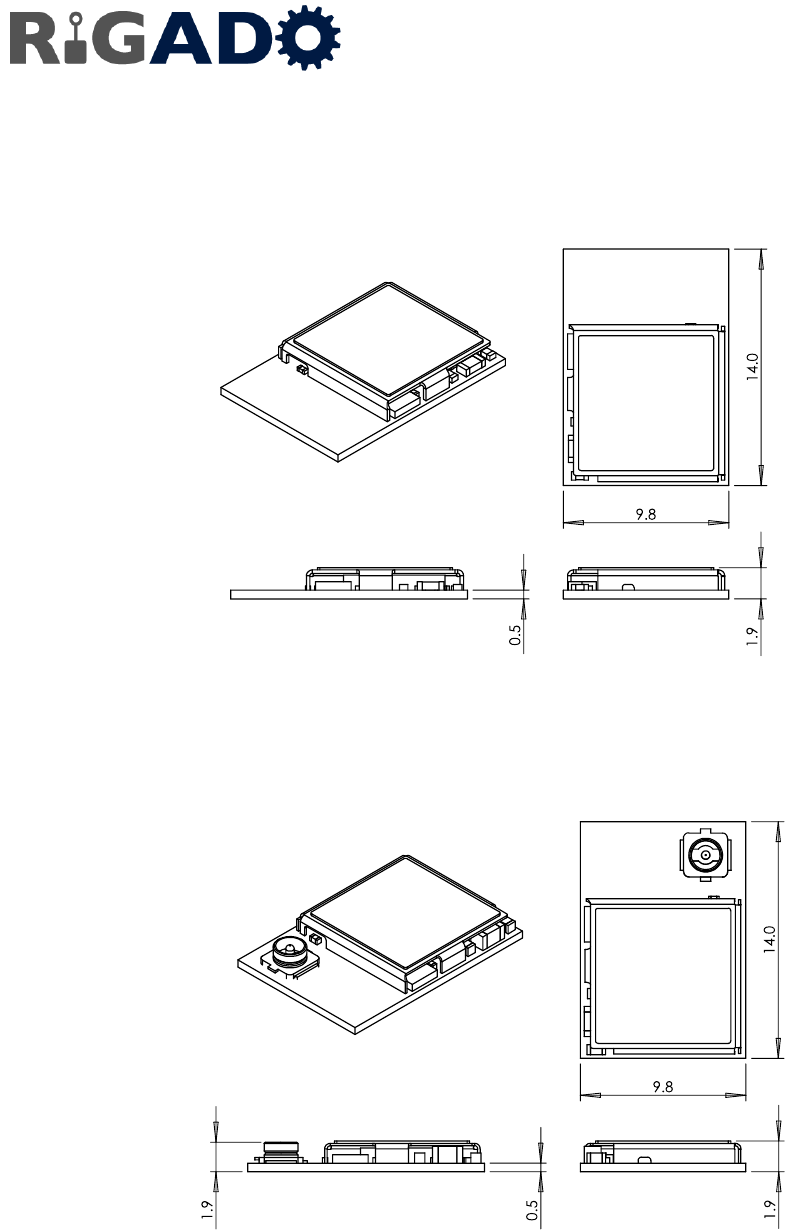
BMD-300 Series Module Datasheet
Bluetooth 4.2 LE
03/23/2016
BMD-300-DS-V0.9.4 Page 13 of 25
9. Mechanical Data
9.1 BMD-300 Dimensions
Figure 4 – Module Dimensions
(All dimensions are in mm)
9.2 BMD-301 Dimensions
Figure 5 – Module Dimensions
(All dimensions are in mm)
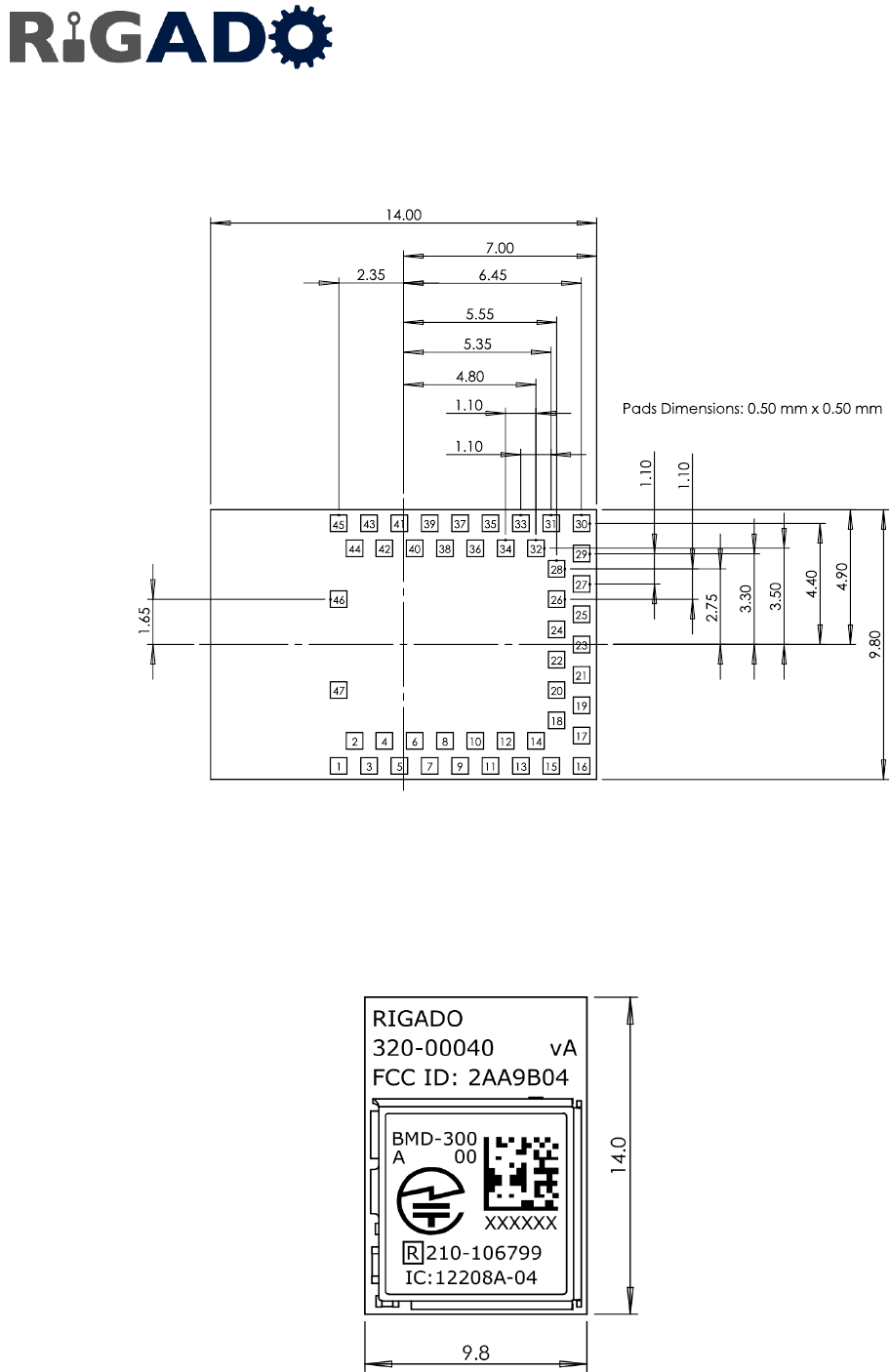
BMD-300 Series Module Datasheet
Bluetooth 4.2 LE
03/23/2016
BMD-300-DS-V0.9.4 Page 14 of 25
9.3 Recommended PCB Land Pad
The BMD-300 and BMD-301 have identical PCB layout footprints.
Figure 6 – Module Dimensions
(All dimensions are in mm)
10. Module Marking
10.1 BMD-300 Module Marking
Figure 7 – Module Marking – Rev A – BMD-300

BMD-300 Series Module Datasheet
Bluetooth 4.2 LE
03/23/2016
BMD-300-DS-V0.9.4 Page 15 of 25
10.2 BMD-301 Module Marking
Figure 8 – Module Marking – Rev A – BMD-301
11. RF Design Notes
11.1 Recommended RF Layout & Ground Plane
For the BMD-300, the integrated antenna requires a suitable ground plane to radiate effectively.
The area under and extending out from the antenna portion of the module should be kept clear of copper and
other metal. The module should be placed at the edge of the PCB with the antenna edge facing out.
Figure 9 – Recommended RF Layout

BMD-300 Series Module Datasheet
Bluetooth 4.2 LE
03/23/2016
BMD-300-DS-V0.9.4 Page 16 of 25
For the BMD-301, refer to the external antenna datasheet for antenna placement and grounding
recommendations.
11.2 Mechanical Enclosure
For the BMD-300, care should be taken when designing and placing the module into an enclosure. Metal
should be kept clear from the antenna area, both above and below. Any metal around the module can
negatively impact RF performance.
The module is designed and tuned for the antenna and RF components to be in free air. Any potting, epoxy fill,
plastic over-molding, or conformal coating can negatively impact RF performance and must be evaluated by
the customer.
For the BMD-301, refer to the external antenna datasheet for placement in or on a mechanical enclosure.
12. Evaluation Boards
Rigado has developed full featured evaluation boards that provide a complete I/O pin out to headers, on-
board programming and debug, 32.768 kHz crystal, power & virtual COM port over USB, 4 user LEDs, and 4
user buttons. The evaluation boards also provide the option to be powered from a CR2032 coin cell battery,
and have current sense resistors and headers to allow for convenient current measurements. An Arduino Uno
R3 style header is provided for easy prototyping of additional functions. The evaluation boards also support
programming off-board BMD-300 modules.
13. Custom Development
Rigado is a full-service design house offering end-to-end product development from concept to
manufacturing. We can provide custom modules and do electrical and mechanical design, end product
manufacturing, firmware and mobile development, and web and cloud integration. Please contact Rigado at
info@rigado.com or 1-866-6-RIGADO for custom engineering options and fees.

BMD-300 Series Module Datasheet
Bluetooth 4.2 LE
03/23/2016
BMD-300-DS-V0.9.4 Page 17 of 25
14. Bluetooth Qualification (pending)
The BMD-300 Series modules are qualified as a Bluetooth End Product with Declaration ID TBD using Nordic’s
S132 SoftDevice (Bluetooth Smart 4.2). The BMD-300 Series has also been certified as a Component (tested)
for RF-PHY with Declaration ID TDB. This allows customers to use different SoftDevices that have been
certified by Nordic without the need to complete additional RF-PHY testing, provided that the design is not
changed.
15. Regulatory Statements
Note: Regulatory Statements are for reference only pending the completion of testing and approvals.
15.1 FCC Statement:
This device has been tested and found to comply with part 15 of the FCC rules. These limits are designed to
provide reasonable protection against harmful interference in a residential installation. This equipment
generates, uses and can radiate radio frequency energy and, if not installed and used in accordance with the
instructions, may cause harmful interference to radio communications. However, there is no guarantee that
interference will not occur in a particular installation. If this equipment does cause harmful interference to
radio or television reception, which can be determined by turning the equipment off and on, the user is
encouraged to try to correct the interference by one or more of the following measures:
Reorient or relocate the receiving antenna.
Increase the separation between the equipment and the receiver
Connect the equipment into an outlet on a circuit different from that to which the receiver is
connected.
Consult the dealer or an experienced radio/TV technician for help.
Operation is subjected to the following two conditions: (1) This device may no cause harmful interference, and
(2) this device must accept any interference received, including interference that may cause undesired
operation. Note: Modification to this product will void the user’s authority to operate this equipment.
Note: Modification to this product will void the users’ authority to operate this equipment.
15.2 FCC Important Notes:
(1) FCC Radiation Exposure Statement
This equipment complies with FCC RF radiation exposure limits set forth for an uncontrolled environment. This
transmitter must not be co-located or operating in conjunction with any other antenna or transmitter.
This equipment complies with Part 15 of the FCC Rules. Operation is subject the following two conditions:
(1) This device may not cause harmful interference, and
(2) This device must accept any interference received, including interference that may cause undesired
operation.
The devices must be installed and used in strict accordance with the manufacturer’s instructions as described
in this document.
Caution!
The manufacturer is not responsible for any radio or TV interference caused by unauthorized modifications to
this equipment. Such modification could void the user authority to operate the equipment.

BMD-300 Series Module Datasheet
Bluetooth 4.2 LE
03/23/2016
BMD-300-DS-V0.9.4 Page 18 of 25
(2) Co-location Warning:
This device and its antenna(s) must not be co-located or operating in conjunction with any other transmitter
antenna.
(3) OEM integration instructions:
This device is intended only for OEM integrators under the following conditions:
The antenna and transmitter must not be co-located with any other transmitter or antenna. The module shall
be only used with the integral antenna(s) that has been originally tested and certified with this module.
As long as the two (2) conditions above are met, further transmitter testing will not be required. However, the
OEM integrator is still responsible for testing their end-product for any additional compliance requirements
with this module installed (for example, digital device emission, PC peripheral requirements, etc.)
In the event that these conditions cannot be met (for example certain laptop configuration or co-location with
another transmitter), then the FCC authorization for this module in combination with the host equipment is
no longer considered valid and the FCC ID of the module cannot be used on the final product. In these and
circumstance, the OEM integrator will be responsible for re-evaluating. The end product (including the
transmitter) and obtaining a separate FCC authorization.
Caution!
The OEM is still responsible for verifying compliance with FCC Part 15, subpart B limits for unintentional
radiators through an accredited test facility.
(4) End product labeling:
The final end product must be labeled in a visible area with the following:
BMD-300: “Contains FCC ID: 2AA9B04”
BMD-301: “Contains FCC ID: 2AA9B04”
Any similar wording that expresses the same meaning may be used.
The FCC Statement below should also be included on the label. When not possible, the FCC Statement should
be included in the User Manual of the host device.
“This device complies with part 15 of the FCC rules.
Operation is subject to the following two conditions. (1) This device may not cause harmful
interference. (2) This device must accept any interference received, including interference that may
cause undesired operation.”
(5) Information regarding the end user manual:
The OEM integrator has to be aware not to provide information to the end user regarding how to install or
remove this RF module in the user’s manual of the end product which integrates this module. The end user
manual shall include all required regulatory information/warning as show in this manual (Section 15.2(4)).

BMD-300 Series Module Datasheet
Bluetooth 4.2 LE
03/23/2016
BMD-300-DS-V0.9.4 Page 19 of 25
15.3 IC Statement:
This device complies with Industry Canada license-exempt RSS standard(s). Operation is subject to the
following two conditions: (1) this device may not cause interference, and (2) this device must accept any
interference, including interference that may cause undesired operation of the device.
Le présent appareil est conforme aux CNR d'Industrie Canada applicables aux appareils radio exempts de
licence. L'exploitation est autorisée aux deux conditions suivantes : (1) l'appareil ne doit pas produire de
brouillage, et (2) l'utilisateur de l'appareil doit accepter tout brouillage radioélectrique subi, même si le
brouillage est susceptible d'en compromettre le fonctionnement.
RF exposure warning: The equipment complies with RF exposure limits set forth for an uncontrolled
environment. The antenna(s) used for this transmitter must not be co-located or operating in conjunction with
any other antenna or transmitter.
Avertissement d'exposition RF: L'équipement est conforme aux limites d'exposition aux RF établies pour un
incontrôlés environnement. L'antenne (s) utilisée pour ce transmetteur ne doit pas être co-localisés ou
onctionner en conjonction avec toute autre antenne ou transmetteur .
15.4 IC Important Notes:
1. The OEM integrator has to be aware not to provide information to the end user regarding how to install or
remove this RF module in the user manual of the end product.
The user manual which is provided by OEM integrators for end users must include the following information in
a prominent location.
2. To comply with IC RF exposure compliance requirements, the antenna used for this transmitter must not be
co‐located or operating in conjunction with any other antenna or transmitter, except in accordance with IC
multi‐transmitter product procedures.
3. The final system integrator must ensure there is no instruction provided in the user manual or customer
documentation indicating how to install or remove the transmitter module except such device has
implemented two‐ways authentication between module and the host system.
4. The host device shall be properly labelled to identify the module within the host device. The final end
product must be labeled in a visible area with the following:
BMD-300: “Contains IC: 12208A-04“
BMD-301: “Contains IC: 12208A-04 “
Any similar wording that expresses the same meaning may be used.
The IC Statement below should also be included on the label. When not possible, the IC Statement should be
included in the User Manual of the host device.
“This device complies with Industry Canada license-exempt RSS standard(s). Operation is subject to
the following two conditions: (1) this device may not cause interference, and (2) this device must
accept any interference, including interference that may cause undesired operation of the device.
Le présent appareil est conforme aux CNR d'Industrie Canada applicables aux appareils radio exempts
de licence. L'exploitation est autorisée aux deux conditions suivantes : (1) l'appareil ne doit pas
produire de brouillage, et (2) l'utilisateur de l'appareil doit accepter tout brouillage radioélectrique
subi, même si le brouillage est susceptible d'en compromettre le onctionnement.”
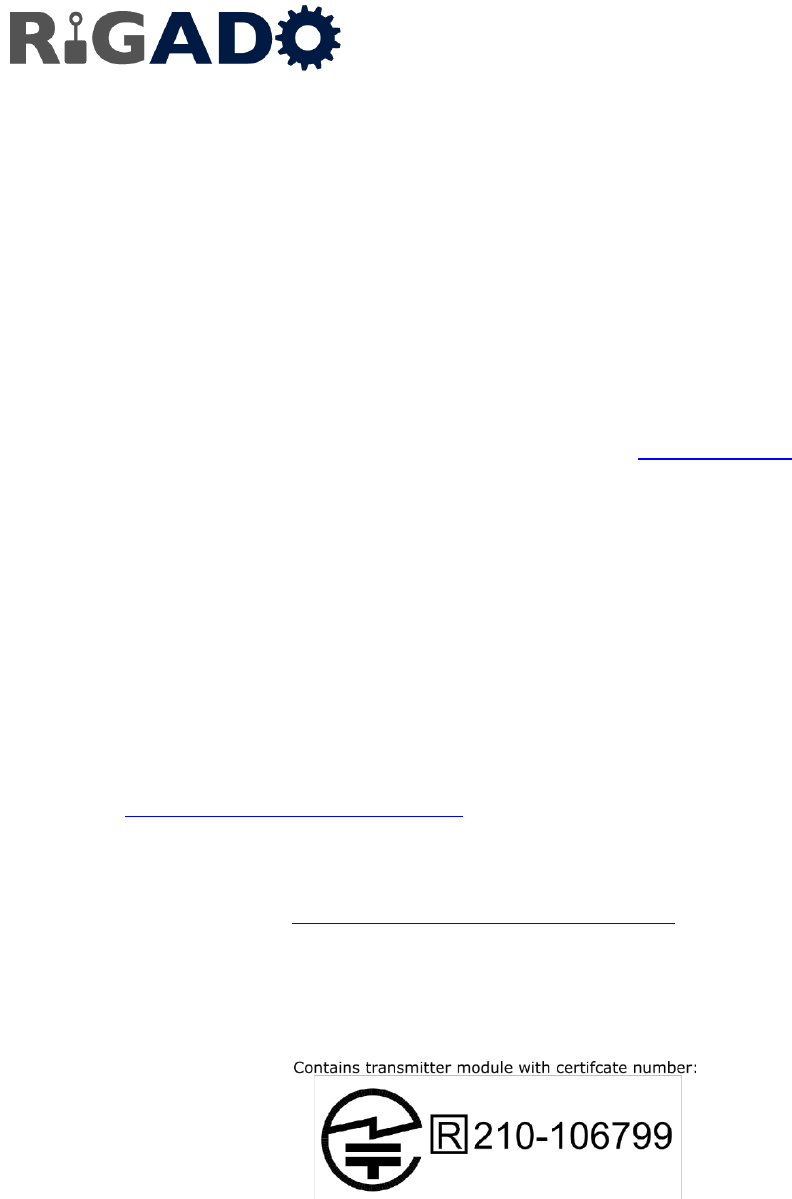
BMD-300 Series Module Datasheet
Bluetooth 4.2 LE
03/23/2016
BMD-300-DS-V0.9.4 Page 20 of 25
15.5 CE Regulatory:
This device will be tested and compliant against the following standards. OEM integrators should consult with
qualified test house to verify all regulatory requirements have been met for their complete device.
From Directive 2006/95/EC:
EN 60950-1: 2006 + A11: 2009 + A1: 2010 + A12: 2011
From R&TTE Directive 1999/5/EC:
ETSI EN 300 328 V 1.8.1
From Directive 2004/108/EC:
ETSI EN 301 489-1 V1.9.2
EN 61000-3-2: 2014, EN 61000-3-3:2013
ETSI EN 301 489-17 V2.2.1
Declarations of Conformity and supporting test reports are available at www.rigado.com.
15.6 Japan (MIC)
The BMD-300 Series modules have received type certification and is labeled with its own technical conformity
mark and certification number as required to conform to the technical standards regulated by the Ministry of
Internal Affairs and Communications (MIC) of Japan pursuant to the Radio Act of Japan. Integration of this
module into a final end product does not require additional radio certification provided installation
instructions are followed and no modifications of the module are allowed. Additional testing may be required:
• If the host product is subject to electrical appliance safety (for example, powered from an AC mains),
the host product may require Product Safety Electrical Appliance and Material (PSE) testing. The
integrator should contact their conformance laboratory to determine if this testing is required.
• There is a voluntary Electromagnetic Compatibility (EMC) test for the host product administered by
VCCI: http://www.vcci.jp/vcci_e/index.html
The label on the final end product which contains a BMD-300 Series module must follow the MIC marking
requirements. Labeling requirements for Japan available at the Ministry of Internal Affairs and
Communications (MIC) website: http://www.tele.soumu.go.jp/e/index.htm.
The BMD-300 module is labeled with its assigned technical conformity mark and certification number. The
final end product in which this module is being used must have an external label referring to the type certified
module inside:

BMD-300 Series Module Datasheet
Bluetooth 4.2 LE
03/23/2016
BMD-300-DS-V0.9.4 Page 21 of 25
15.7 Australia / New Zealand
The BMD-300 Series modules have been tested to comply with the AS/NZS 4268 :2012+AMDT 1:2013, Radio
equipment and systems – Short range devices – Limits and methods of measurement. The report may be
downloaded from www.rigado.com, and may be used as evidence in obtaining permission to use the RCM.
Information on registration as a Responsible Party, license and labeling requirements may be found at the
following websites:
Australia: http://www.acma.gov.au/theACMA/radiocommunications-short-range-devices-standard-2004
New Zealand: http://www.rsm.govt.nz/compliance
The A-Tick and C-Tick marks are being migrated to the Regulatory Compliance Mark (RCM). Only Australian-
based and New Zealand-based companies who are registered may be granted permission to use the RCM. An
Australian-based or New Zealand-based agent or importer may also register as a Responsible Party to use the
RCM on behalf of a company not in Australia or New Zealand.
15.8 Approved External Antennas
The antennas listed below were tested for use with the BMD-301.
#
Manufacturer
Part Number
Max Gain
Type
Size
Approvals
1
Pulse
W1030
2 dBi
1/4 Wave Dipole – Whip
Length: 108.3mm
FCC, IC
2
Taoglas
FXP73.07.0100A
2.5dBi
1/4 Wave Dipole – Flex
7mm x 47mm x 0.1mm
FCC, IC
3
Pulse
W1027
3.2 dBi
1/4 Wave Dipole – Whip
Length: 136.8mm
FCC, IC
4
Kinsun
6670113050-145
2.0 dBi
1/4 Wave Dipole – PCB
12mm x 65mm x 0.46mm
FCC, IC
5
Kinsun
6610103081
5.0 dBi
1/2 Wave Dipole – Whip
Length: 196.6mm
FCC, IC
Table 11 - Approved External Antennas
16. Solder Reflow Temperature-Time Profile
Figure 10 – Reflow Profile for Lead Free Solder
16.1 Moisture Sensitivity Level
The BMD-300 Series is rated for MSL 3, 168-hour floor life after opening.

BMD-300 Series Module Datasheet
Bluetooth 4.2 LE
03/23/2016
BMD-300-DS-V0.9.4 Page 22 of 25
17. Packaging and Labeling
17.1 Carrier Tape Dimensions
Figure 11 – Carrier Tape Dimensions
17.2 Reel Packaging
Modules come on 330mm reels loaded with 1000 modules. Each reel is placed in an antistatic bag with a
desiccant pack and humidity card and placed in a 340x350x65mm box. On the outside of the bag an
antistatic warning and reel label are adhered.
Figure 12 – Reel Cartons
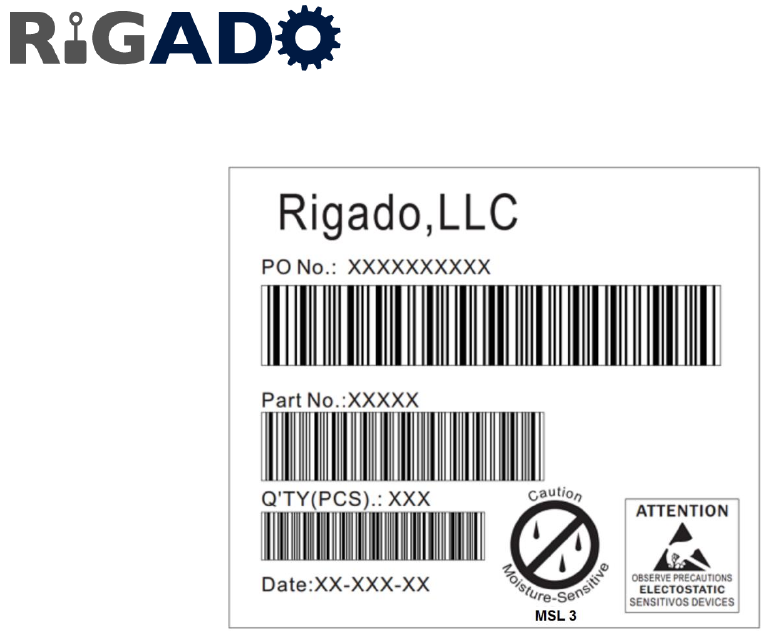
BMD-300 Series Module Datasheet
Bluetooth 4.2 LE
03/23/2016
BMD-300-DS-V0.9.4 Page 23 of 25
17.3 Packaging Label
Figure 13 – Packaging Label

BMD-300 Series Module Datasheet
Bluetooth 4.2 LE
03/23/2016
BMD-300-DS-V0.9.4 Page 24 of 25
18. Cautions
1) The guidelines of this document should be followed in order to assure proper performance of the
module.
2) This product is for use in office, business, and residential applications, but not medical devices.
3) This module may short-circuit. If a short circuit can result in serious damage or injury then failsafe
precautions should be used. This could be accomplished by redundant systems and protection circuits.
4) Supply voltage to the module should not be higher than the specified inputs or reversed. Additionally,
it should not contain noise, spikes, or AC ripple voltage.
5) Avoid use with other high frequency circuits.
6) Use methods to eliminate static electricity when working with the module as it can damage the
components.
7) Contact with wires, the enclosure, or any other objects should be avoided.
8) Refer to the recommended pattern when designing for this module.
9) If hand soldering is used, be sure to use the precautions outlined in this document.
10) This module should be kept away from heat, both during storage and after installation.
11) Do not drop or physically shock the module.
12) Do not damage the interface surfaces of the module.
13) The module should not be mechanically stressed at any time (storage, handling, installation).
14) Do not store or expose this module to:
Humid or salty air conditions
High concentrations of corrosive gasses.
Long durations of direct sunlight.
Temperatures lower than -40°C or higher than 125°C.
19. Life Support Policy
This product is not designed to be used in a life support device or system, or in applications where there is
potential for a failure or malfunction to, directly or indirectly, cause significant injury. By using this product in
an application that poses these risks, such as described above, the customer is agreeing to indemnify Rigado
for any damages that result.
20. Document History
Revision
Date
Changes / Notes
0.8
11/06/2015
Initial preliminary release
0.8.1
11/10/2015
Updated Table 5, Figure 5, Section 7.5
Corrected antenna references
0.8.2
11/11/2015
Updated Figure 1
0.8.3
11/20/2015
Updated current ratings from nRF52832 OPC v0.6.3
Corrected Table 3
0.9
03/17/2016
Added BMD-301, GPIO notes, MSL, updated certifications, updated electrical specifications
0.9.4
03/23/2016
Added BMD-301 antennas

BMD-300 Series Module Datasheet
Bluetooth 4.2 LE
03/23/2016
BMD-300-DS-V0.9.4 Page 25 of 25
21. Related Documents
Rigado Documents:
BMD-300-Series-EVAL-UG: Evaluation Kit User Guide
RIGDFU-DS-1: RigDFU Secure Bootloader Datasheet
BMDWARE-DS-1: BMDware Datasheet
Nordic Documents:
Visit infocenter.nordicsemi.com for a comprehensive library of Nordic technical documentation.
nRF52832-PS: nRF52832 Product Specification
S132-SDS – nRF52832 S132 Soft Device Specification
S212-SDS – nRF52832 S132 Soft Device Specification
S332-SDS – nRF52832 S132 Soft Device Specification